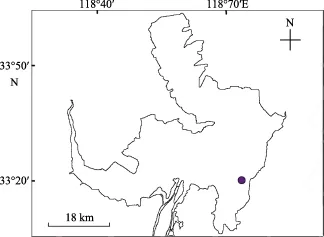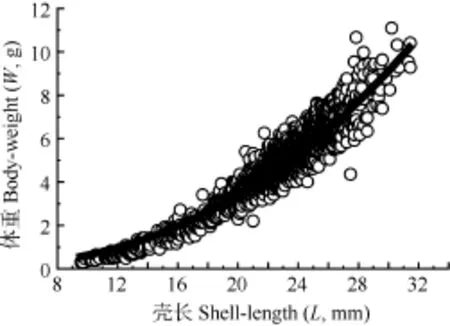基于殼長頻率分析的洪澤湖河蜆漁獲物年齡結構、生長與死亡參數估計
畢婷婷侯 剛張勝宇謝松光
(1. 中國科學院水生生物研究所, 中國科學院水生生物多樣性與保護重點實驗室, 武漢 430072; 2. 中國科學院大學,北京 100049; 3. 廣東海洋大學水產學院, 湛江 524025; 4. 江蘇省洪澤湖漁業管理委員會辦公室, 淮安223300; 5. 中國科學院水生生物研究所淮安研究中心, 蘇北湖群漁業可持續發展與水環境保護重點實驗室, 淮安 223002)
基于殼長頻率分析的洪澤湖河蜆漁獲物年齡結構、生長與死亡參數估計
畢婷婷1,2侯 剛1,3張勝宇4謝松光1,5
(1. 中國科學院水生生物研究所, 中國科學院水生生物多樣性與保護重點實驗室, 武漢 430072; 2. 中國科學院大學,北京 100049; 3. 廣東海洋大學水產學院, 湛江 524025; 4. 江蘇省洪澤湖漁業管理委員會辦公室, 淮安223300; 5. 中國科學院水生生物研究所淮安研究中心, 蘇北湖群漁業可持續發展與水環境保護重點實驗室, 淮安 223002)
河蜆(Corbicula fluminea)廣泛分布于東南亞、澳大利亞和非洲等地區的河流和淡水湖泊中[1,2], 它也是我國一些湖泊中(如太湖、洪澤湖)十分重要的經濟貝類[3—6]。其中, 洪澤湖河蜆資源量曾達1×108kg以上, 分布遍及全湖除水草資源特別豐富的水域。但近年來, 由于外來污水進入湖體、過度捕撈以及捕撈生產中漁民2.27使用農藥煤氣等的影響,河蜆資源量下降, 2012年洪澤湖河蜆資源調查得出資源量為5.00×107kg, 比2011年的6.92×107kg下降28.80%, 比2010年的7.84×107kg下降36.20%, 分布區域明顯縮小(江蘇省洪澤湖漁業管理委員會辦公室, 未發表數據)。
目前, 關于河蜆的研究主要集中在生物學特征、時空分布與環境因子的關系以及繁殖生物學特征方面[2,7—9],種群結構、生長和死亡的研究較少。種群的年齡結構、生長和死亡等基本參數是漁業資源管理的基礎[10], 并且研究證明對于不能通過硬組織確定年齡的漁業對象, 體長頻率分析方法是確定漁獲物年齡結構的有效手段[10—12]。本文通過洪澤湖河蜆漁獲物的殼長頻數數據, 對河蜆漁獲物的年齡結構、生長和死亡參數進行分析, 評估洪澤湖河蜆資源利用狀況, 為制定合理的資源管理對策提供指導。
1 材料與方法
1.1 研究位置和采樣方法
2011年8月至2012年7月逐月于洪澤湖河蜆主要分布水域(33°20′N,118°75′E)(圖 1)采集河蜆, 采樣工具為漁民捕撈河蜆用的耙柵, 孔徑6 mm。河蜆洗凈后置于敞口桶中、避光, 活體帶回實驗室進一步處理。
1.2 實驗室處理
從每月采集的河蜆樣品中隨機選取195—200個個體,用游標卡尺測量殼長(L, 0.10 mm), 電子天平稱取體重(W, 0.01 g), 采用冪函數方程擬合殼長-體重關系。

圖1 洪澤湖中采樣點的地理位置Fig. 1 Collection site of Corbicula fluminea in the Hongze Lake, Jiangsu Province, China
1.3 數據分析
根據河蜆生長的季節性特點, 采用von Bertalanffy季節性生長方程擬合河蜆生長方程[13,14]:

式中, L∞為漸近殼長, K為生長曲線的平均速率, t0為假設的理論生長起點年齡, ts為“夏季點”取0和1之間的值, C為季節性波動的幅度, 即為“振幅”, 通常取0和1之間的值, C值越大, 生長的季節性波動越大。
采用FISAT 軟件中的ELEFAN I技術估算模型生長參數[15]。首先采用Powell-Wetherall 方法估測漸近殼長L∞[16]。以此為初始值, 擬合 von Bertalanffy 季節性生長方程的生長參數L∞、K、C和“冬季點”WP。
理論生長起點年齡t0采用Pauly經驗公式估算[17]:

總死亡系數(Z)用 FISAT 軟件中的長度變換漁獲曲線法(Length-Converted Catch Curve)估算[17]。
自然死亡系數(M)采用以下公式計算[17]:

式中, T為河蜆棲息水域年平均水溫。洪澤湖年平均水溫取15.6℃[18]。
捕撈死亡系數(F)和開發率(E)由以下公式計算:

2 結果
共測定2390個河蜆個體, 殼長和體重范圍分別為8.50—31.40 mm和0.37—11.34 g。殼長與體重呈冪函數關系(圖2):

Powell-Wetherall方法估算初始L∞值為34.3 mm。Von Bertalanffy季節性生長方程生長參數的擬算值: L∞=35.80 mm, K=0.72, C=0.91, WP=0.09, Rn=0.275, t0≈–0.21a。從生長曲線圖分析, 漁獲物由3個世代構成; 低齡世代8、9月開始補充進入漁獲物中; 生長曲線的斜率有明顯的季節性波動:春季至夏季斜率逐漸升高(7月份最高), 秋季至冬季則逐漸降低(1月份最低)。低齡階段殼長生長快(圖 3)。
基于以上生長參數, 采用長度變換漁獲曲線法獲得總死亡系數( Z )為4.31(圖4), 自然死亡系數( M )為1.05,捕撈死亡系數( F )為3.26, 開發率( E )為0.76。

圖 2 河蜆殼長(L)-體重(W)關系Fig. 2 Relationships between shell-length and body-weight of C. fluminea

圖3 河蜆殼長頻數分布數據擬合的季節性生長曲線圖(L∞=35.80 mm, K=0.72, C=0.91, WP=0.09, Rn=0.275)Fig. 3 Seasonalized von Bertalanffy growth curve (L∞=35.80 mm shell length, K= 0.72 per year, C=0.91, WP=0.09, Rn=0.275) of Corbicula fluminea as superimposed on the restructured shell length–frequency histogram

圖4 變換體長漁獲曲線估計河蜆總死亡系數Z=4.31Fig. 4 Estimated Z=4.31 per year base on length-coverted catch curve of Crobicula fluminea
3 討論
洪澤湖河蜆殼長-體重符合冪函數關系, 冪指數 b為2.44。采用ELEFAN I技術分析洪澤湖河蜆殼長頻率, 估算河蜆漁獲物包括3個世代。殼長生長系數K為0.72, 振幅C為0.91, 冬季點WP為0.09, 種群的開發率E為0.76。
洪澤湖河蜆的繁殖季節集中, 貝殼的生長具有明顯的季節性特點, 適于采用體長頻率分析方法分析年齡結構[10]。但是采用體長頻率分析方法估算漁獲物年齡結構時, 由于高齡組體長分布常存在明顯重疊, 可能低估年齡結構[8,10]; 另外, 由于捕撈的選擇性, 低齡個體常不出現在漁獲物中。基于本研究結果推測, 洪澤湖河蜆種群至少包括 3個年齡組, 與其他水體河蜆種群的年齡結構認識基本一致[8,9,19]。
冪指數 b值表明殼長屬非勻速生長[20]。在一些河蜆入侵水域中K范圍為0.070—0.65, Paraná River Delta中入侵種群振幅 C為 0.70, 相較而言, 洪澤湖河蜆生長較快,生長的季節性波動較大[8]。生長曲線分析表明春季至夏季生長率逐漸升高, 最大生長率約發生在7月, 秋季至冬季生長率逐漸降低, 最小生長率約發生在1月(冬季點)。從河蜆充分實現種群周年生長效率考慮, 河蜆捕撈在 7月之后比較恰當。本研究確定洪澤湖河蜆種群的開發率 E為0.76, 表明資源目前處于過度開發狀態[21,22]。捕撈死亡系數上升是引起河蜆總死亡系數上升的主要因子, 為了降低河蜆死亡率恢復資源應降低捕撈量。
由于采用體長頻率方法確定漁獲物年齡結構的局限性, 需要進一步建立河蜆貝殼截面年齡分析方法來確證本研究的結果。
[1] Clavero M, Araujo R, Calzada J, et al. The first invasive bivalve in African fresh waters: invasion portrait and management options [J]. Aquatic Conservation: Marine and Freshwater Ecosystems, 2012, 22(2): 277—280
[2] Karatayev A Y, Padilla D K, Minchin D, et al. Changes in Global Economies and Trade: the Potential Spread of Exotic Freshwater Bivalves [J]. Biological Invasions, 2007, 9(2): 161—180
[3] Li D L, Zhang T, Yu J B, et al. Temporal and spatial distributional patterns of mollusca in a typical aquacultural lake—Datong Lake [J]. Acta Hydrobiologica Sinica, 2011, 35(6): 946—954 [李德亮, 張婷, 余建波, 等. 典型養殖湖泊大通湖軟體動物的時空分布格局. 水生生物學報, 2011, 35(6): 946-954]
[4] Yan Y J, Li X Y. Secondary production of several dominant macrozoobenthos in Heizhuchong stream of Hanjiang River Basin [J]. Acta Hydrobiologica Sinica, 2007, 12(3): 1—306 [閆云君, 李曉宇. 漢江流域黑竹沖河部分優勢大型底棲動物的周年生產量. 水生生物學報, 2007, 12(3): 1—306]
[5] Zhang C W, Zhang T L, Zhu T B, et al. Community structure of macrozoobenthos and its relationship with environmental factors in Lake Hongze [J]. Journal of Hydroecology, 2012, 33(3): 27—33 [張超文, 張堂林, 朱挺兵, 等. 洪澤湖大型底棲動物群落結構及其與環境因子的關系. 水生態學雜志, 2012, 33(3): 27—33]
[6] Zhang H C, Chen M, Fan H F, et al. Climatic background of modern Corbicula fluminea and the stable isotopes of shells from the representative areas in continental China [J]. Marine Geology & Quaternary Geology, 2007, 27(3): 77—84 [張虎才, 陳明, 樊紅芳, 等. 河蜆分布的氣候環境及殼體穩定同位素. 海洋地質與第四紀地質, 2007, 27(3): 77—84]
[7] Araujo R, Moreno D, Ramos M A. The asiatic clam Corbicula fluminea (Müller, 1774) (Bivalvia: Corbiculidae) in Europe [J]. American Malacological Bulletin, 1993, 10: 39—49
[8] Cataldo D, Boltovskoy D. Population dynamics of Corbicula fluminea (Bivalvia) in the Paraná River Delta (Argentina) [J]. Hydrobiologia, 1999, 380: 153—163
[9] Mouthon J. Life cycle and populations dynamics of the Asian clam Corbicula fluminea (Bivalvia: Corbiculidae) in the Saone River at Lyon (France) [J]. Hydrobiologia, 2001, 452: 109—119
[10] Sparre P, Venema S C. Introduction to Stock Assessment of Tropical Fish [M]. Beijing: Chinese Agricultural Science and Technology Press. 1992, 407 [ Sparre P, Venema S C. 熱帶魚類資源評估導論. 北京:中國農業科技出版社. 1992, 407]
[11] Li Z. The study on the performances of length-frequency analysis methods on the simulated and real fishery data sets [D]. Thesis for Master of Science. Ocean University of China, Qingdao. 2006 [李壯. 漁業體長頻數分析法在模擬和實際漁業中的應用. 碩士學位論文, 中國海洋大學, 青島. 2006]
[12] Pauly D, David N. ELEFAN I, a BASIC program for the objective extraction of growth parameters from length-frequency data [J]. Berichte der Deutschen Wissenschaftlichen Kommission für Meeresforschung, 1981, 28(4): 205—211
[13] Ituarte C F. Growth dynamics in a natural population of Cor-bicula fluminea (Bivalvia, Sphaeriacea) at punta atalaya, río de la plata, Argentina [J]. Studies on Neotropical Fauna and Environment, 1985, 20(4): 217—225
[14] Pauly D. A review of the ELEFAN System for Analysis of length–frequency data in Fish and Aquatic Invertebrates [A]. In: Pauly D, Morgan G R (Eds.), Length-Based Methods in Fisheries Research [C]. Manila: ICLARM Conference Proceedings 13. 1987, 7—34
[15] Gayanilo F C, Sparre P, Pauly D. FAO-ICLARM stock assessment tools II User’s guide [M]. Rome: FAO Computerized Information Series (Fisheries), No. 8, Revised version. 2005, 168
[16] Pauly D. On improving operation and use of the ELEFAN programs, part 2, improving the estimation of L∞[J]. Fishbyte, 1986, 4(1): 18—20
[17] Pauly D. On the interrelationships between natural mortality, growth parameters, and mean environmental temperature in 175 fish stocks [J]. Journal du Conseil / Conseil Permanent International pour l'Exploration de la Mer, 1980, 39(2): 175—192
[18] Yang S J. Protection and sustainable use of biodiversity of West Lakeside zone of Hongze Lake [J]. Bulletin of Soil and Water Conservation, 2003, 23(5): 62—69 [楊士建. 洪澤湖西部湖濱的生物多樣性保護與可持續利用. 水土保持通報, 2003, 23(5): 62—69]
[19] Sousa R, Antunes C, Guilhermino L. Ecology of the invasive Asian clam Corbicula fluminea (Müller, 1774) in aquatic ecosystems: an overview [J]. Annales de Limnologie-International Journal of Limnology, 2008, 44(2): 85—94
[20] Ecoutin J M, Albaret, J J, Trape S. Length–weight relationships for fish populations of a relatively undisturbed tropical estuary: the Gambia [J]. Fisheries Research, 2005, 72: 347—351
[21] Uneke B I, Nwani C D, Okogwu O, et al. Growth, mortality, recruitment and yield of Pellonula leonensis Boulenger, 1917 (Osteichthyes: Clupeidae) in a tropical flood river system [J]. Journal of Fisheries International, 2010, 5(1): 19—26
[22] Ye J Q, Xu Z L, Chen J J, et al. Resources status analysis of large yellow croaker in Guanjinyang using von Bertalanffy growth equation and fishing mortality parameters [J]. Journal of Fisheries of China, 2012, 36(2): 238—246 [葉金清,徐兆禮, 陳佳杰, 等. 基于生長和死亡參數變化的官井洋大黃魚資源現狀分析. 水產學報, 2012, 36(2): 238—246]
STUDY ON AGE STRUCTURE, GROWTH AND MORTALITY OF CORBICULA FLUMINEA IN HONGZE LAKE, CHINA, THROUGH SHELL LENGTH-FREQUENCY DATA ANALYSIS
BI Ting-Ting1,2, HOU Gang1,3, ZHANG Sheng-Yu4and XIE Song-Guang1,5
(1. The Key Laboratory of Aquatic Biodiversity and Conservation of Chinese Academy of Sciences, Institute of Hydrobiology, Chinese Academy of Sciences, Wuhan 430072, China; 2. University of Chinese Academy of Sciences, Beijing 100049, China; 3. Fisheries College, Guangdong Ocean University, Zhanjiang 524025, China; 4. Hongze Lake Fisheries Administration Committee Office of Jiangsu Province, Huai’an 223300, China; 5. Key Laboratory of Sustainable Fisheries and Environmental Protection for Lake of Northern Jiang-su, Huai’an Research Center, Institute of Hydrobiology, Chinese Academy of Sciences, Huai’an 223002, China)
河蜆; 殼長頻數; 年齡結構; 生長; 死亡
Corbicula fluminea; Shell length-frequency data; Age structure; Growth; Mortality
Q959.21
A
1000-3207(2014)04-0797-04
10.7541/2014.111
2013-02-26;
2013-11-15
淮安市重點實驗室項目(HAP201204); 淮安市科技支撐項目(SN1182; SN12100)資助
畢婷婷(1989—), 女, 安徽長豐人; 碩士; 主要從事動物學研究。E-mail: bijun515@163.com
謝松光, E-mail: xiesg@ihb.ac.cn

